This story appears in the Spring 2024 issue of DePauw Magazine.
Story by George Spencer, Photos by Brittney Way Cooper
The DePauw campus celebrated a rare celestial event when the path of totality of a solar eclipse crossed central Indiana. While astronomers of every stripe descended upon the Hoosier state for one day in hopes of getting the best view, the campus community came together in the weeks preceding the event to contemplate the sun, the moon and the stars, and how they relate to the human experience. Whether inspired by a total solar eclipse, an eclipse-themed poetry reading, a southwestern desert observatory or our own campus physics and astronomy facilities, DePauw turns its attention to the heavens to consider both the scientific and ethereal nature of the cosmos. Starting with the big event first…
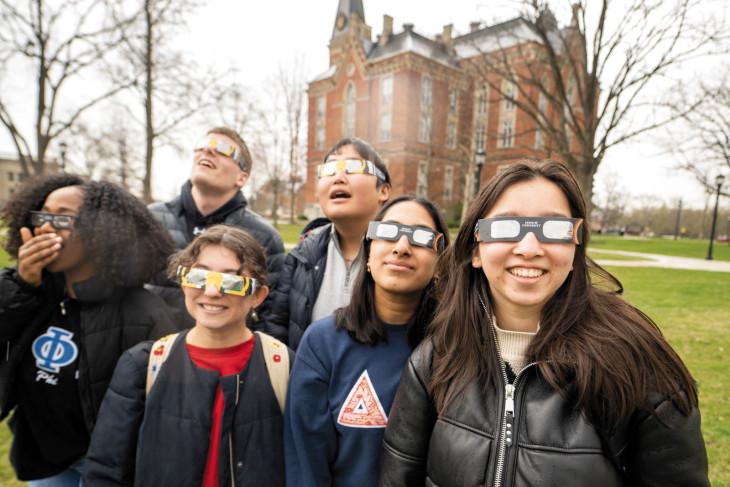
The Day: April 8, 2024
As envisioned on March 31, 2024
There’s no doubt about it. Our sun was the star of the show. Just as warm-up acts precede the headline act, the DePauw community spent the weeks, days and hours ahead of April’s total solar eclipse revving up for the long-expected blackout.
Students spun like heavenly bodies at a dance party the day before. Poetry readings teased out secret meanings of the solar spectacle. Special lectures by physics and astronomy professors delved into the clockwork geometries of orbital mechanics. Suddenly everyone knew words like umbra, penumbra and corona.
Eclipse devotees attended a Classics department lecture on the Antikythera mechanism, an ancient Greek star clock of mystifying complexity. This mechanical marvel predicted eclipses decades in advance. Even the Economics department got into the act with a talk on how solar events impact commerce.
From 1:49 p.m. to 4:20 p.m. on Monday, April 8, the rhythm of life slowed, especially during the brief totality that began at 3:05. Necks ached. Eyes squinted. With luck, viewers saw stars and Jupiter, Venus, Saturn and Mars aligned with the sun.
When darkness fell, feelings of awe, humility, and perhaps dread shoved away any thoughts of homework or exams. Soon light crept back. Many onlookers doubtless sighed with relief – no dragon in the sky had devoured our life-bringing star.
In the end, science prevailed. “A solar eclipse proves the model we created of the Earth going around the sun and the moon going around the Earth is the way things are,” says Howard Brooks, chair of the Physics and Astronomy department.
“Anytime you look up in the sky and look at the universe, it’s a humbling experience. I think that’s a good thing,” adds physics and astronomy professor Alex Komives.
As sure as the sun sets, no one alive today will see Indiana’s next total solar eclipse in 129 years, six months and nine days on October 17, 2153.
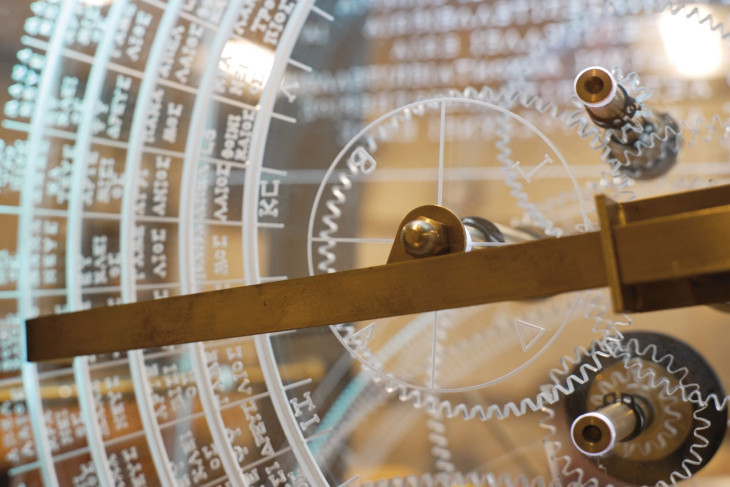
A Beautiful Object
Shown is DePauw’s 3:1 scale model of an object called the Antikythera Mechanism. Its inspiration was an object found at a Greek shipwreck, estimated to be from 2 B.C. This cosmic calculator could tell you, with one turn of the dial, the positions of the sun, the moon, the phases of the moon, the positions of all five planets and it could predict both lunar and solar eclipses. Watch professor Pedar Foss explain:
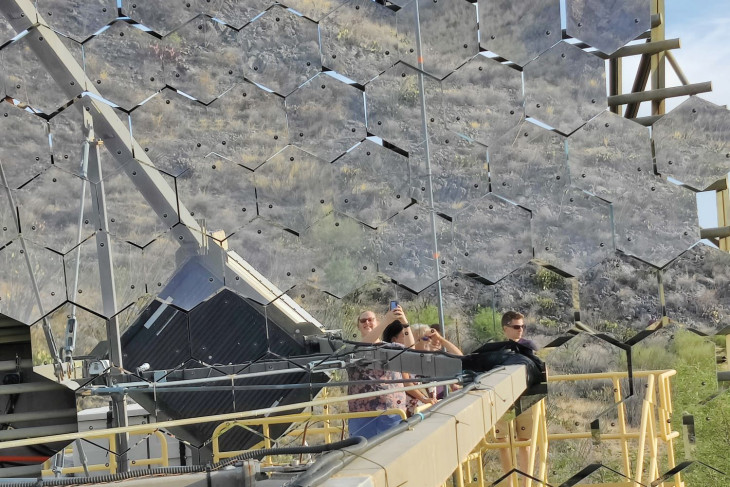
The Truth About Quasars
Solar eclipses come and go, but quasars, pulsars and blazars get scrutinized by DePauw scholars all the time.
This otherworldly research happens on Mt. Hopkins in southern Arizona at VERITAS, the Very Energetic Radiation Imaging Telescope Array System. Every summer physics and astronomy professor Mary Kertzman and assistant professor Avery Archer take students there.
The seven telescopes at VERITAS (the word means “truth” in Latin) zero in on gamma rays hurtling toward Earth from other galaxies. This super-energetic form of light is expelled by supermassive black holes. Their pull is so fantastic they suck matter – and light – down their gravitational wells. Then something unknown happens. “Somehow that material gets transferred into quasars – jets of high-energy gamma rays directed towards us if the geometry is right. We’d like to understand the fundamental physics involved in that,” says Kertzman.
Only a handful of facilities in the world study quasars and their kin. VERITAS is the only site in the U.S. that does this research. “To have DePauw’s name on virtually every publication from VERITAS is a good thing, and to have DePauw students, all undergraduates of course, going there is a huge thing,” she says.
The students are all physics and astronomy majors. “It’s a lot of fun and a good experience to take them there to look at these extreme phenomena,” says Archer.
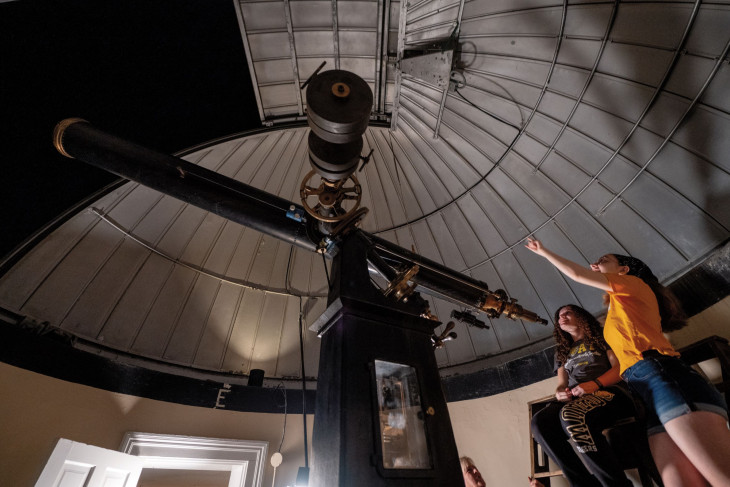
For Heavenly Views
Curiosity seekers got a treat at the McKim Observatory the weekend before the eclipse. They climbed its spiral oak staircase and peered out three porthole windows on the way to its second floor. Having risen a few feet closer to the heavens, under the domed ceiling they beheld McKim’s 12-foot-long Clark Refractor telescope.
With its gleaming metal fittings, this elegant instrument – Indiana’s oldest working telescope – might have reminded McKim’s first visitors of the latest marvels in a Jules Verne novel or H.G. Wells’ “War of the Worlds.”
Physics professor Mary Kertzman sometimes tells astronomers from other colleges that DePauw has a Clark telescope. “Their jaws drop and they gasp, ‘Oh, my gosh, you have a Clark!’ They’re that rare,” she says.
The telescope’s 9.53-inch-diameter lens remains world-class thanks to its clarity, and the telescope delivers images of planets and nebulae as amazing as those revealed by a 21st century instrument. Where it once served in active astronomical research, technological advances – like the VERITAS array, and space-based telescopes like the Hubble and James Webb – combine with increased local light pollution to limit McKim’s role to that of a teaching facility.
Built in 1884, McKim is listed on the National Register of Historic Places. The stucco-covered brick building, with its distinctive aluminum dome and octagonal tower, was controversial when it was built, thanks to its then-remote location on a 120-acre farm named University Park. Later, DePauw nixed a plan to relocate the entire campus to that property, originally purchased by the university with that goal in mind. Then in 1914 and 1915 the stellar outpost found itself in the middle of a six-hole golf course. Today it nestles near the historic Northwood residential neighborhood off Franklin Avenue on Greencastle’s northeast side.
When Halley’s Comet last swung by Earth in 1986, McKim hosted hordes of evening visitors. For the chance at a moment’s glimpse through the telescope, they waited in a line that wound down the street. Because the totality of this year’s eclipse was only about four minutes, the physics and astronomy department opted against viewing inside McKim. Instead, the DePauw community was encouraged to gather in and around Bowman Park.
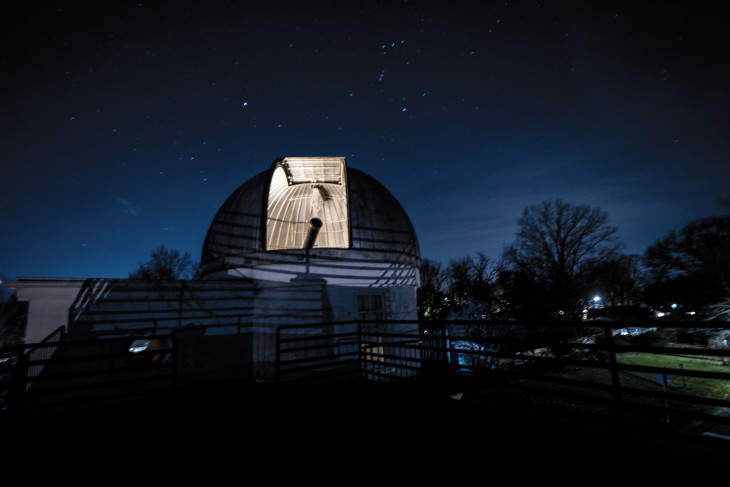
The Hidden Sun: Haiku exhibition
Haiku inspired by the solar eclipse brought poets together on March 13. Dubbed “The Hidden Sun” by organizer Joyce Brinkman of Brick Street Poetry, the exhibition proved that brevity is the soul of wit – these traditional three-line Japanese poems always have 17 syllables written in a five-seven-five pattern.
“We are connected to the sun and moon. Great haiku comments on nature to give insight into human nature,” says Brinkman.
Poet Alex Komives, who is also a professor of physics and astronomy, contributed a haiku. “There’s a lot of beauty in physics. It lends itself to poetic expression,” he says. “Playing with words to me is as interesting as playing with numbers. It’s different, but there’s a lot of commonality in both.”
The authors, many of whom are alumni or students, also read their works at a livestreamed March event in Thompson Recital Hall that featured performances by local musicians. A sampling:
Blinded by the moon
Can’t see the light of our Earth
Still can’t see myself
– Yiran Zhao, DePauw student from China
moon’s smoke shadow drifts
dark visits untarnished earth
people cover eyes
– Joe Heithaus, professor of English
Keep your favorite saint
Like embers in your pocket
See God lights our path
– Eugene Gloria, professor of English
Behind an eyelid
Barely containing itself
Careless dahlia
– Alex Puga, professor of Hispanic Studies and director of the Hispanic Studies Program
solar sea urchin
splayed kaleidoscopic spines
pierce my drunken eyes
– Alex Komives, professor of physics and astronomy, director of DePauw University Nuclear Physics Laboratories, distant relative of Nicolaus Copernicus
For more photos and videos related to the eclipse and astronomy at DePauw, visit the eclipse resource page.
DePauw Magazine
Spring 2024
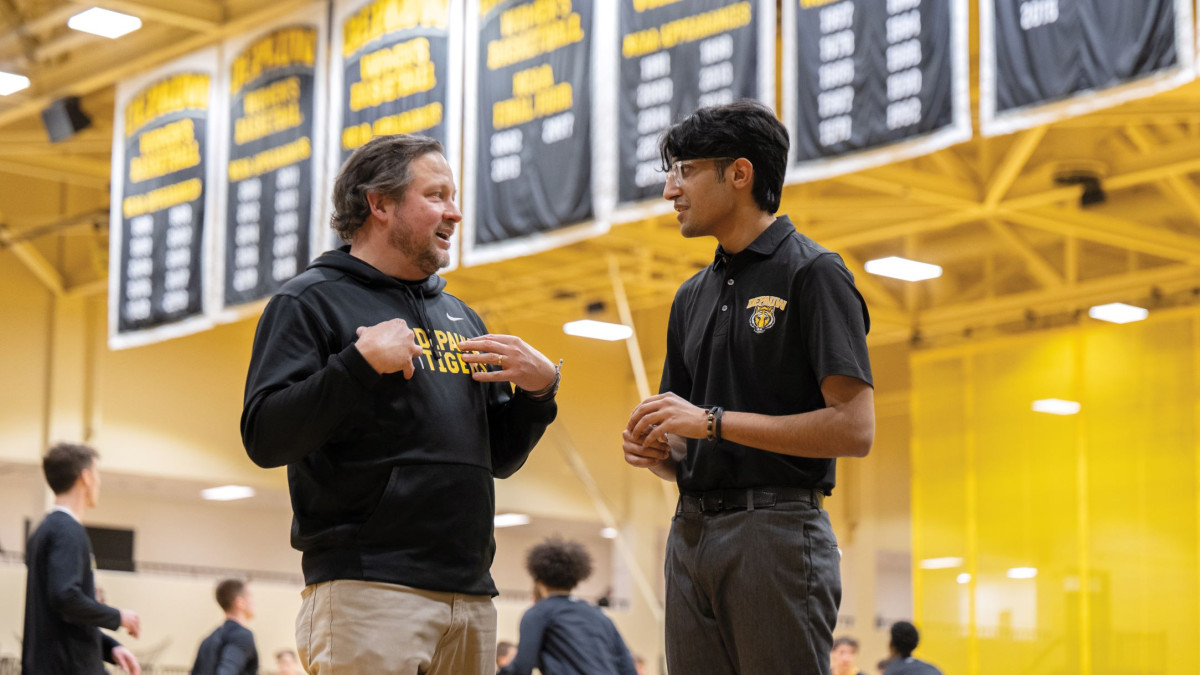 Threads of Gold
Threads of Gold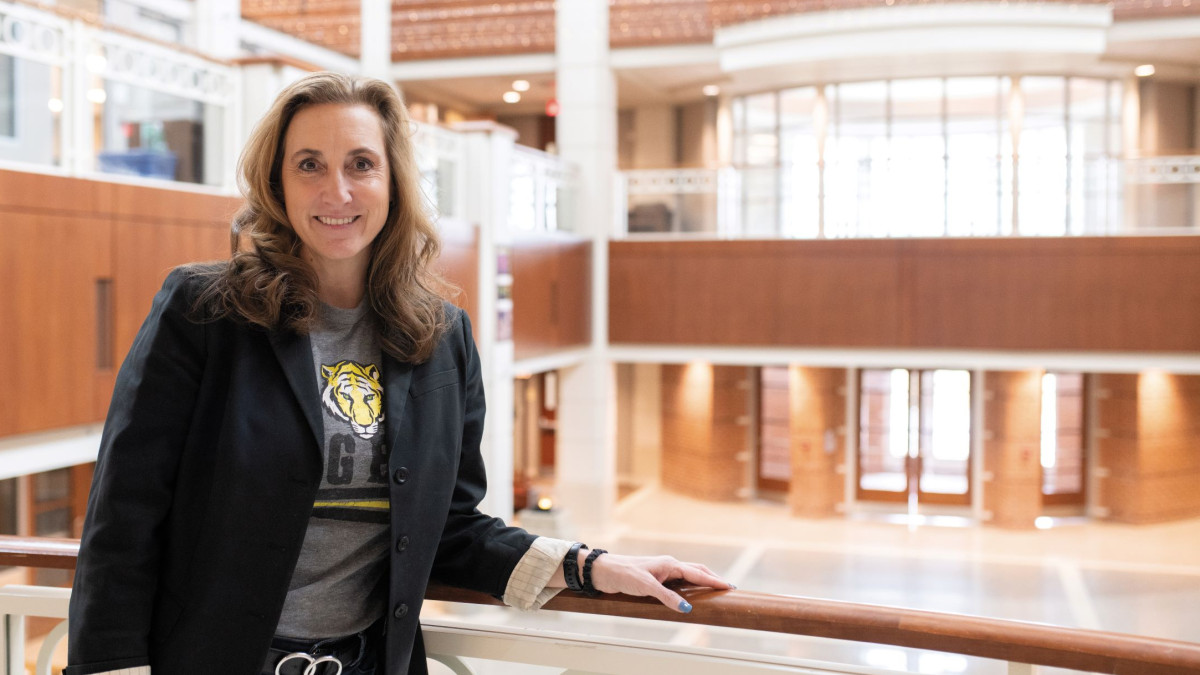 Phyllis Barkman Ferrell ’94: Global Health Leader, DePauw Loyal
Phyllis Barkman Ferrell ’94: Global Health Leader, DePauw Loyal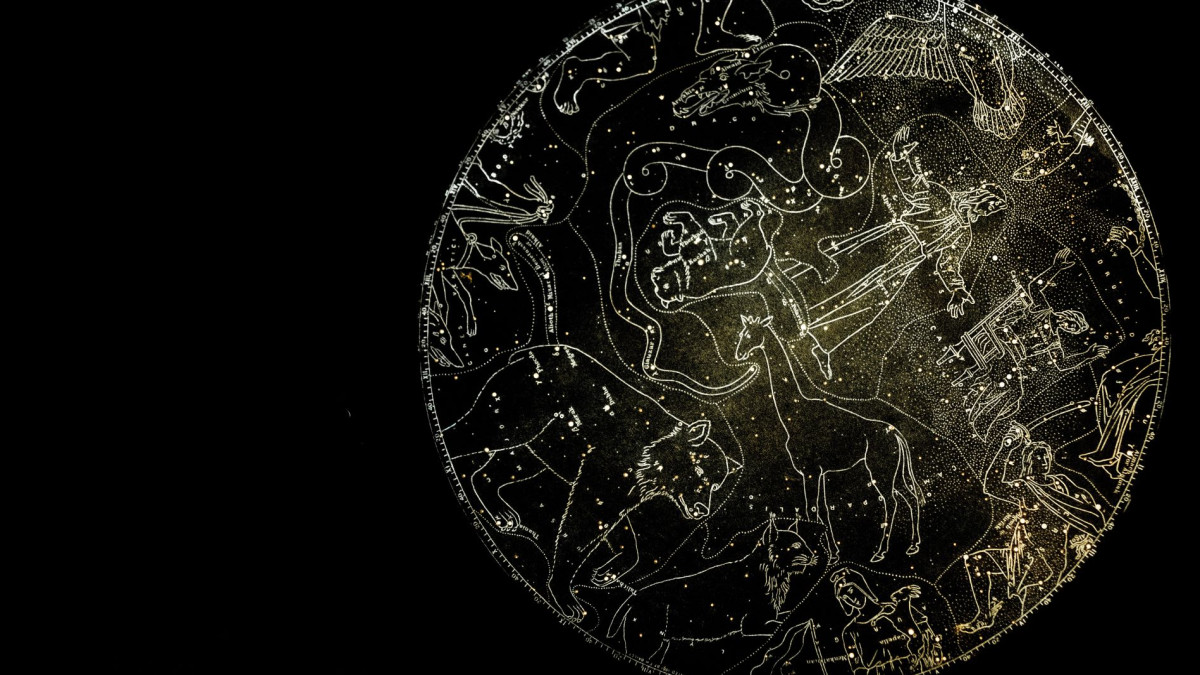 The Path of Totality
The Path of Totality
DePauw Stories
A GATHERING PLACE FOR STORYTELLING ABOUT DEPAUW UNIVERSITY
Browse other stories
-
Athletics
-
Men's Basketball - DePauw Extends Win Streak to Five; Jacobs Reaches 1,000-Point Plateau
-
Women's Basketball - Tigers Top Ephs for Third Straight Win
-
Women's Basketball - Tigers Open Music City Classic with Win over Simpson
More Athletics
-
-
News
-
Student and Professor Share Unexpected Writing Journey
-
Four in a Row! DePauw Wins 131st Monon Bell Classic
-
Jim Rechtin '93 Featured in Fortune Magazine
More News
-
-
People & Profiles
-
Entrepreneurs Eric Fruth ’02 and Matt DeLeon ’02 Are Running More Than a Business
-
Rick Provine Leaves Legacy of Leadership and Creativity
-
History Graduate Cecilia Slane Featured in AHA's Perspectives on History
More People & Profiles
-
-
Have a story idea?
Whether we are writing about the intellectual challenge of our classrooms, a campus life that builds leadership, incredible faculty achievements or the seemingly endless stories of alumni success, we think DePauw has some fun stories to tell.
-
Communications & Marketing
101 E. Seminary St.
Greencastle, IN, 46135-0037
communicate@depauw.eduNews and Media
-
News media: For help with a story, contact:
Bob Weaver, Senior Director of Communications.
bobweaver@depauw.edu.